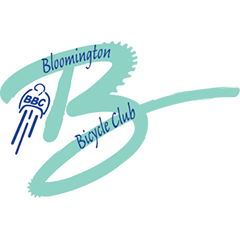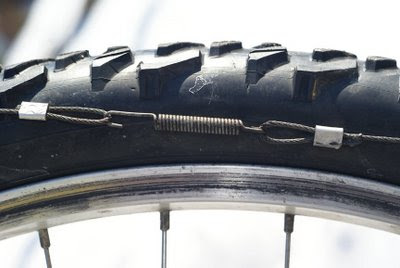By Keith Vogelsang
Why let a little snow get in the way of cycling fun? With a few dollars worth of hardware and a sturdy mountain bike, you can transform your off-road trail machine into a winter snow machine. Dedicated winter cyclists often invest in studded bike tires. A less expensive option, however, is to outfit your existing wheels with steel chains that provide the extra traction needed to chew through snow and ice.
If your intended route is especially steep or icy, you will want chains or studded tires for both wheels. I have found that for most days, I get sufficient traction with chains strapped to the front wheel only. Yes, riding with chains is noisy and much less efficient than riding without them. But winter riding has a special kind of charm, where efficiency becomes a much lower priority than it does during nicer riding weather. And there is something deeply satisfying about crunching through snow and ice on a bike under conditions that keep most folks inside the house crunching only potato chips. There will always be time to eat chips, but how often do we get to ride in the snow in Bloomington?
Here’s what you need to make chains for one tire:
– 20 feet of galvanized picture wire (70lb test or better)
– Approximately 2 feet of number 14 (0.08″ diameter) zinc plated jack chain.
– 2 hooked-end extension springs (0.08″ wire diameter)
– 4 aluminum compression sleeves to match picture wire
– Needle nose pliers
– Channel lock or line pliers
(Note: For corrosion resistance, stainless steel wire and chain would be better than using galvanized steel, but galvanized steel is relatively cheap and easy to find at most hardware stores, whereas stainless steel is not.)
Assembly (see photos):
Getting the length and width of the chains to properly match your tire can be tricky. For obvious reasons, the chains must clear the brakes and the frame. Front wheels are easier, as there is more clearance near the fork than there is along the rear wheel chain stay. If your bike has disc brakes, then the task is much simpler than it is for cantilever or V-brake systems. For a 2″ tire, 5 chain links per section work well for the front, but the rear might only have clearance for 4 links across. Each section should be separated by about 2 inches.
To determine the length of picture wire needed, measure the circumference of your fully inflated tire and wheel. If you like math, the formula for determining your wheel’s circumference is π * diameter. If you don’t like math, just run a length of wire around the circumference of the wheel, or use a chalk line and roll your wheel along the ground to complete one revolution and then measure the completed distance.
I’ve included photos of my set up. You’ll notice the actual wires (with looped ends) are a few inches less than the wheel circumference because they are designed to fit just below the knobby tread, and the looped ends are connected with an extension spring that must remain tight. A bit of trial and error may be needed to determine the optimal length for your particular tires. Consider, too, that installing the completed chains requires a partially or fully deflated tire. Once everything is lined up and the springs connected, inflating the tire pulls everything tight and keeps the chains from shifting around during use (very important!).
Once you’ve settled on the proper length, create loops in the picture wire using the aluminum compression sleeves. These sleeves can easily be crimped with pliers. When properly installed, the extension spring rides along the tire sidewall and pulls these two looped ends together .
Beginning just after a crimped sleeve, use your pliers to open and crimp chain sections as needed, taking care to minimize to exposed wire on the chain that could cause a flat. Working with one side of the chain first, measure and crimp approximately every two inches, or in a pattern that matches the knobby tread on your tire. Measure and crimp. Measure and crimp. Measure. And. Crimp. When you get to the end of one side, open the opposing link and connect the opposing wire to the assembly, working one section at a time. When your hand begins to ache from crimping, you are probably done. If not, keep going until you have enough 5-link chain sections in place to provide sufficient traction.
When everything is installed and the tire re-inflated, you should not see or hear any loose hardware, and the wheel should spin freely. If you get to this point in the project, you really should turn the computer off and go out and ride. The snow won’t last long.



